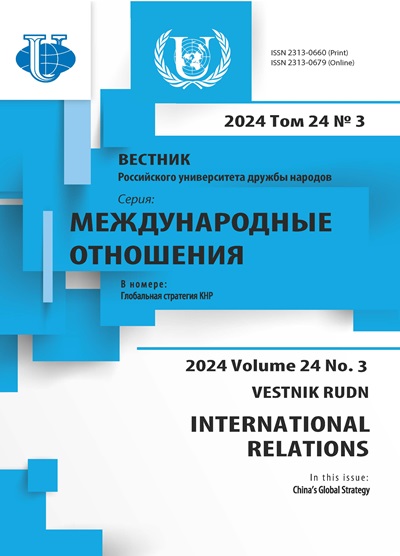Иран и Саудовская Аравия на Ближнем Востоке: лидерство и межрелигиозная конфликтность (2011-2017)
- Авторы: Диансаи Б.1
-
Учреждения:
- Российский университет дружбы народов
- Выпуск: Том 18, № 1 (2018): Великие державы: парадоксы восприятия
- Страницы: 124-134
- Раздел: МИР И БЕЗОПАСНОСТЬ
- URL: https://journals.rudn.ru/international-relations/article/view/18381
- DOI: https://doi.org/10.22363/2313-0660-2018-18-1-124-134
Цитировать
Полный текст
Аннотация
Отношения между Ираном и Саудовской Аравией всегда были далеки от идеальных. Революция 1979 г. в Иране, падение режима Саддама Хусейна в Ираке и арабская весна привели к еще большим разногласиям между этими региональными державами. В статье анализируются отношения Ирана и Саудовской Аравии на Ближнем Востоке в период с 2011 по 2017 г. Обе страны претендуют на лидерство среди мусульманских стран Ближневосточного региона, в котором шиитское государство - Иран и суннито-ваххабитское государство - Саудовская Аравия преследуют противоположные интересы, участвуя в многочисленных идеологических и политических конфликтах. В результате в регионе сформировалась сложная многофакторная ситуация с участием Ирана и Саудовской Аравии, для анализа которой автором были использованы общенаучные аналитические методы: логические, типологические, индуктивно-дедуктивные методы, а также системный подход. Особое внимание автор уделяет фактору межрелигиозной конфликтности как важному инструменту в процессе трансформации регионального порядка, анализируя деятельность основных акторов в рамках исламского дискурса в регионе - Ирана и Саудовской Аравии, усиливающей свои позиции также и в рамках арабского дискурса. Сделан вывод о том, что Иран и Саудовская Аравия желают увеличить свою долю на Ближнем Востоке и, говоря о религиозной перспективе, готовы к расширению своего влияния в ближневосточных странах.
Об авторах
Безад Диансаи
Российский университет дружбы народов
Email: behzaddiansaee@gmail.com
аспирант кафедры теории и истории международных отношений Российского университета дружбы народов
Список литературы
- Al-Smadi, Fatima. (2017). Iran and the Arab Revolutions: Narratives Establishing Iran’s Monopolism. 18 March 2017. URL: http://studies.aljazeera.net/en/reports/2017/03/iran-arab-revolutions-narratives-establishing-irans-monopolism-170318050125225.html (accessed: 22.12.2017)
- Borujerdi, A.H. (2016). Development of Arab-Iranian relations. Tehran: Publishing house of Ministry of Foreign Affairs
- El-Labbad, M. (2014). Egypt: A Regional Reference in the Middle East. In: Regional Powers in the Middle East: New Constellations after the Arab Revolts. Ed. by H. Furtig. New York: Palgrave, p. 81-91
- Esfandiary, D. & Tabatabai, A. (2016). Yemen: An Opportunity for Iran-Saudi Dialogue? The Washington Quarterly, 39 (2), 155-174. DOI: https://doi.org/10.1080/0163660X.2016.1204415
- Filipkova, L., Hesova, Z., Karasek, T., Kubikova, N., Kuzvart, J. & Zahora, J. (2012). NATO and the Arab Spring: challenge to cooperation, Opportunity for Action? Association for International Affairs. URL: https://www.amo.cz/wp-content/uploads/2015/11/pp-2012-01.pdf (accessed: 10.09.2017)
- Firas, Abu Hilal. (2011). Iran and the Arab Revolutions: positions and Repercussions. Arab Center for Research and Policy Studies. Doha. URL: https://www.dohainstitute.org/en/lists/ACRPS-PDFDocumentLibrary/Iran_and_the_Arab_Revolutions_Positions_and_Repercussions.pdf (accessed: 04.04.2016)
- Gause, G. (2011). Is Saudi Arabia really counter-revolutionary? The Middle East channel. Foreign policy. URL: http://foreignpolicy.com/2011/08/09/is-saudi-arabia-really-counter-revolutionary/ (accessed: 16.03.2017).
- Gause, G.F. (2014). Beyond Sectarianism: The New Middle East Cold War. Brookings Doha Center. URL: https://www.brookings.edu/wp-content/uploads/2016/06/English-PDF-1.pdf (accessed: 12.03.2017).
- Gause, G. (2015). The Future of U.S - Saudi Relations: The Kingdom and the Power. Foreign Affairs, 95(4). URL: https://www.foreignaffairs.com/articles/united-states/2016-06-13/future-us-saudi-relations (accessed: 16.03.2017).
- Goodarzi, J.M. (2013). Syria and Iran: Alliance Cooperation in a Changing Regional Environment. Middle East Studies, 4 (2), 31-59.
- Hinnebusch, R. (2014). The Arab Uprisings and The MENA Regional States System. Uluslararasi iliskiler-International relations, 11(42), 7-27.
- Hinnebusch, R.A. (2016). The Sectarian Revolution in the Middle East. R/Evolutions: Global Trends & Regional Issues, 4(1), 120-152.
- Keynoush, Banafshe. (2016). Saudi Arabia and Iran: Friends or Foes? London: Pallgrave and Macmillan.
- Khoury, N.A. (2013). The Arab Cold War Revisited: The Regional Impact of the Arab Uprising. Middle East Policy, 20 (2), 73-87.
- Kurzman, C. (2012). The Arab Spring: Ideals of the Iranian Green Movement, Methods of the Iranian Revolution. International Journal of Middle East Studies, 44(1), 162-165. DOI: https://doi.org/ 10.1017/S0020743811001346.
- Mabon, S. (2012). The Battle for Bahrain: Iranian-Saudi Rivalry. East Policy, 19(2), 84-97. doi: 10.1111/j.1475-4967.2012.00537.x.
- Malt Zahn, N.V. (2015). The Syria-Iran Axis: Cultural Diplomacy and International Relations in the Middle East (Library of Modern Middle East Studies). London, New York: I.B. Tauris & Co Ltd.
- Matthiesen, T. (2015). Transnational Identities after the Arab Uprising. In: The Gulf Monarchies beyond the Arab spring: changes and challenges. Ed. by L. Narbone & M. Lestra. Florence: European University Institute, p. 32-36. doi: 10.2870/930212.
- Mohseni, P. (2015). Iran and the Arab World after the Nuclear Deal: Rivalry and Engagement in a New Era. Belfer Center for Science and International Affairs. URL: https://www.belfercenter.org/ sites/default/files/legacy/files/Impact%20on%20Arab%20World%20-%20Web.pdf (accessed: 22.08.2017).
- Narbone, L. & Lestra, M. (2015). The Gulf Monarchies beyond the Arab spring: changes and challenges. Florence: European University Institute. doi: 10.2870/930212 URL: http://cadmus.eui.eu/ handle/1814/37734 (accessed: 12.08. 2016).
- O’Bagy, E. (2013). The free Syrian Army. Institute for the Study of War. URL: http://www.understandingwar.org/report/free-syrian-army (accessed: 06.09. 2017).
- Rosen, N. (2010). Aftermath. Following the Bloodshed of America’s wars in the Middle East. N.Y.: Nation books.
- Schmierer, R., Jeffrey, J. F., Nader, A. & Nazer, F. (2016). The Saudi-Iranian Rivalry and the Obama Doctrine. Middle East policy, 23(2), 5-30.
- Shaw, M. (2009). Sociological approaches to international relations. URL: https://www.eolss.net/ sample-chapters/C14/E1-35-01-07.pdf (accessed: 12.08. 2016).
- Thiel, T. (2012). After the Arab Spring power shift in Middle East? Yemen’s Arab Spring: from youth revolution to fragile political transition. LSE Research Online. London School of Economics and Political Science. URL: http://eprints.lse.ac.uk/43465/1/After%20the%20Arab% 20Spring_Yemen%E2%80%99s%20Arab%20Spring%28lsero%29.pdf (accessed: 02.09.2017)
- Ulrichsen, K.C. (2015). The Uprising in Bahrain: Regional Dimensions and International Consequences. In: Routledge Handbook of the Arab Spring: Rethinking Democratization. Ed. by Labra Sadiki. New York: Routledge Taylor & Francis Group, p. 133-144











